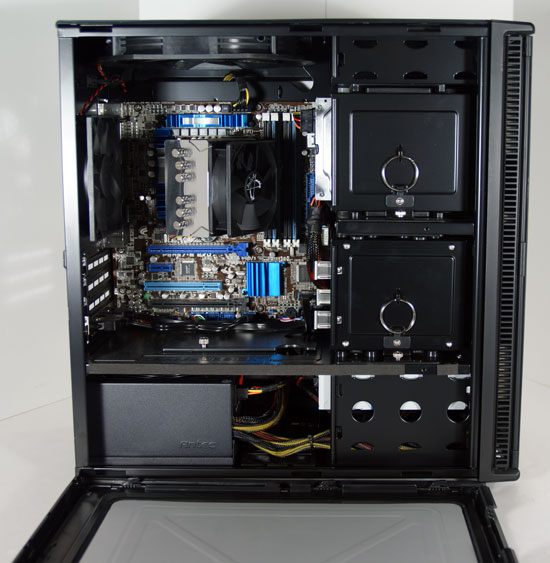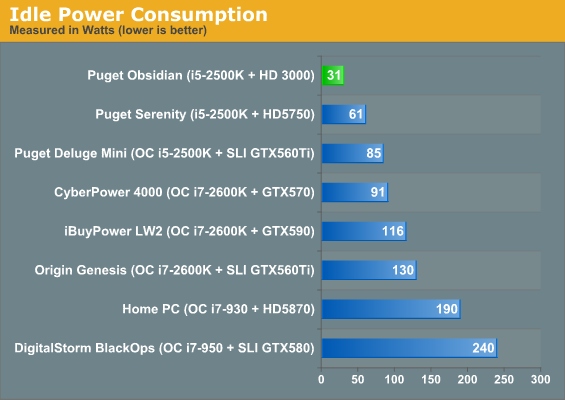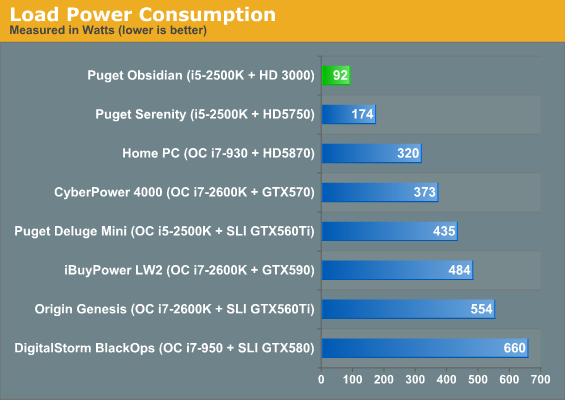Puget Systems Obsidian: Solid as a Rock
by Dustin Sklavos on April 7, 2011 6:15 PM EST- Posted in
- Systems
- Intel
- Puget Systems
Build, Noise, Heat, and Power Consumption
It's at this juncture that I really want to get into the meat and potatoes of how Puget Systems goes about selecting parts to offer in their Obsidian tower, because this is where they really shine. The build itself is solid, well made, and at least appears to use excellent hardware, but there's much more going on than is immediately obvious.
One of the keys with the Obsidian (and to a lesser extent the rest of Puget Systems' machines) is constant review and revision of the hardware available. The staff of Puget Systems meets weekly to go over existing support tickets and checks on every system that needs some form of repair or hardware replacement, looking for trends or bad batches of parts. Second is a tendency towards simplicity; you can't augment the Obsidian as much as you can other builds, and that's built on the basic principle that the less there is in the system, the less that can go wrong. Third, they have a tendency to lag the technology in this line behind some of the other ones to give extra lead time in case bad batches of parts do creep through and to ensure Obsidian systems are based on mature hardware. Finally, the Obsidian line has a unique service point that the other machines Puget Systems offers don't: they keep what you could basically call a hot spare on hand of every Obsidian they sell. If something goes wrong with one in the field, they have a backup immediately ready to replace it.

The funny thing is that I've really only scratched the surface of the kinds of reliability testing and checks and balances Puget Systems has for the Obsidian (much less their others). I've had the opportunity to actually take a look at some of their raw data, where they burn in hardware, do thermal imaging to check for hot spots, and keep track of failure rates. The end result of all of this testing is that their CEO Jon Bach claims (and I wouldn't be surprised if this were true) they've only ever had to actually advance replace two Obsidian towers in the three years the line has been available. Granted, there aren't nearly as many Obsidian systems in the wild as their are Dell Optiplex or HP Compaq business PCs, but large OEMs seem to focus at least as much on on-site repair and extended warranties as they do on overall reliability.
What we're left with on the Obsidian line is systems that are configured fairly modestly but are maximally reliable. As a result of these modest builds (overclocking isn't offered on this line for what should be obvious reasons) and smart component choices, it won't surprise you to see thermals are incredibly good.

Under heavy load the i5-2500K doesn't even hit 50C. To be fair, the processor is about the only part in the case short of the motherboard chipset generating heat, and Puget Systems has equipped it with the silent but effective Scythe Katana 3.


And under load, the Obsidian doesn't even pull 100 watts. At this point it's fair to suggest the Antec TruePower 650-watt power supply that ships standard with the Obsidian is complete overkill, but that power supply is actually the least expensive and least powerful one they offer in any build. Simplicity wins out here: system power draw at idle and load is impressively low. Puget's attention to detail is worth noting here, too: in our idle power their towers occupy the entire top of the chart. Even their overclocked SLI rig, the Deluge Mini, idles lower than CyberPower's Gamer Xtreme 4000...with a single card.
















27 Comments
View All Comments
dawp - Saturday, April 9, 2011 - link
in most business environments I've been in, all the business critical apps are run of the server and very little is kept on the local machines, mostly personal settings and files. a raid setup for that is 1 more step and/or headache the IT department would have to take.erple2 - Sunday, April 10, 2011 - link
The business community has a server to store critical information, and essentially "dumb terminals" (well, slightly smarter than a true thin client) that are essentially "commodity" hardware. For that user, where a re-build costs nearly nothing (image from a central server via network at the touch of a button), and, you're good to go. All "critical" files (business files - proposals, documents etc) are stored in a collaboration area anyway, and that's backed up with RAID 5 or better, plus off site storage, and you only need the apps on the local machine.For that user, you don't need RAID on the local machines.
PWRuser - Friday, April 8, 2011 - link
"The configuration our Deluge Mini review unit shipped with (what) makes for an interesting comparison with the Origin Genesis we recently reviewed."flexcore - Friday, April 8, 2011 - link
Why couldn't they use a power brick for a machine like this that uses such little power? They would get great efficiency and no noise from it? I don't understand why low power office machines and other computers with low power computers don't use power bricks?Taft12 - Sunday, April 10, 2011 - link
They do. They're called laptops and many large companies provide laptops for most ro all employees.7Enigma - Tuesday, April 12, 2011 - link
Limited upgradability most likely. Remember while few there are custom options that would significantly increase the power draw of the system. I agree though that it should be an option if your build has <150w total system draw. For aesthetics they could still have the power brick inside of the case with just the cord coming out, but you'd get the benefits of the higher efficiency/no noise.MadMinstrel - Sunday, April 10, 2011 - link
I'm not sure what type of office use requires a quad core. Seems like overkill. The five uses of more than two cores are rendering, encoding, web and database servers, some types of scientific calculation and gaming. Machines like the Obsidian are unlikely to ever be faced with one of those. Anything I've missed?bobbozzo - Tuesday, April 12, 2011 - link
Developers - Visual Studio now supports multi-threaded compilation, and of course gcc has for years.bobbozzo - Tuesday, April 12, 2011 - link
Besides, Dell and HP are selling quad-core desktops nowadays.You can't even get a single-core Dell Latitude anymore in the 14" and above size.
shady28 - Sunday, April 10, 2011 - link
I haven't seen any system reviews on Anand or any of the enthusiast sites that I would consider an enterprise / corporate PC. Occasionally you'll get the corporate laptop - like a Dell E6410/20 or something along those lines, but never a corporate desktop.
Those, by and large, are the Optiplex series. If you want to see a real corporate desktop, look at the Optiplex 960, or HP Elite series desktops - or the HP thin clients.
By most enthusiast measures, there are simply well built underpowered PCs. Most of these are still selling with C2D E8400 or E8500 processors and integrated 4500 graphics.
That's all that's needed in 98% of the offices in corporate america.